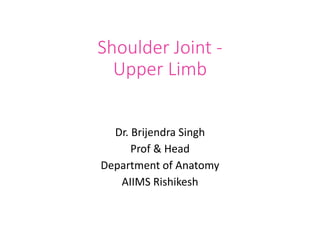
shoulder_jt.pdf
- 1. Shoulder Joint - Upper Limb Dr. Brijendra Singh Prof & Head Department of Anatomy AIIMS Rishikesh
- 2. Learning objectives •Anatomy of shoulder joint •Formation , type & components •Rotator cuff •Relations /nerve & blood supply •Movements & muscles producing them •Dislocations /nerve injuries
- 3. Articulation - Rounded head of humerus & Shallow , glenoid cavity of scapula. Glenoid cavity
- 4. • Articular surfaces are covered by articular - hyaline cartilage. • Glenoid cavity is deepened by fibro cartilaginous rim called glenoid labrum.
- 5. Synovial membrane •lines fibrous capsule & attached to margins of the cartilage covering the articular surfaces. •forms a tubular sheath around the tendon of the long head of biceps brachii. •It extends through anterior wall of capsule to form subscapularis bursa beneath subscapularis muscle.
- 7. Musculotendinious/Rotator cuff •Supraspinatus – superiorly •Infraspinatus & Teres minor- posteriorly •Subscapularis – anteriorly •Long head of triceps – inferiorly ( axillary n & post circumflex humeral artery – lax and least supported) – •most common dislocations – Inferiorly axillary n palsy –loss of abduction
- 8. NERVE SUPPLY of Shoulder joint
- 9. NERVE SUPPLY of Shoulder joint 1. axillary n 2. suprascapular n & 3. lateral pectoral nerve.
- 10. Shoulder joint - spaces Quadrangular space •Sup - teres minor •Inf - teres major •Medially - long head of triceps •Laterally – lateral head of triceps (humerus) •Contents – axillary nerve & posterior circumflex humeral artery Triangular space •Sup – teres major •Medially- long head of triceps •Laterally – triceps(humerus) •Contents – in spiral groove Radial nerve & profunda brachii artery
- 11. Shoulder Joint - Upper Limb Dr Brijendra Singh Prof & Head Department of Anatomy AIIMS Rishikesh
- 13. • Flexion • Extension • Abduction • Circumduction • Lateral rotation • Medial rotation Shoulder joint -movements:
- 14. Flexion - 90° 1. Deltoid - ant 2. Pectoralis major 3. Biceps brachii 4. Coracobrachialis
- 15. Extension is - 45° •Deltoid post •Latissimus dorsi •Teres major
- 16. Abduction: •Initiated - supraspinatus 0 to 18 •19 120 - middle fibers of deltoid. •Subscapularis •Infraspinatus •Teres minor •Above 90 by rotation of scapula •Trapezius & Serratus Anterior
- 17. •Supraspinatus: initiates abduction(0 to 15) and holds the head of the humerus against glenoid fossa of scapula; •Latter function of supraspinatus allows deltoid muscle to contract and abduct humerus at shoulder joint.
- 18. Adduction: Normally upper limb can be swung 45° across front of chest. •pectoralis major •latissimus dorsi •teres major •teres minor
- 19. Lateral rotation Is about 40 - 45°. POST - •infraspinatus •teres minor •posterior fibers of the deltoid muscle 19
- 20. Medial rotation: •Normal medial rotation is about 55°. •performed by : muscles attached at BG - ANT •pectoralis major •Subscapularis •latissimus dorsi •teres major •anterior fibers of deltoid.
- 21. Circumduction: This is a movement in which distal end of humerus moves in circular motion while proximal end remains stable. •It is - 1.Flexion, 2.Abduction, 3.Extension & 4.Adduction Successively
- 23. Inferiorly: 1. the long head of the triceps muscle 2. the axillary nerve 3. the posterior circumflex humeral vessels
- 24. Stability of the shoulder joint •This joint is unstable because of : •shallowness of glenoid fossa •weak ligaments •Its strength almost entirely depends on tone of rotator cuff muscles. •Tendons of these muscles are fused to underlying capsule of shoulder joint. •Least supported part of joint lies in inferior location, where it is unprotected by muscles.
- 25. • A subglenoid displacement of the head of the humerus into the quadrangular space can cause damage to the axillary nerve. • This is indicated by paralysis of the deltoid muscle and loss of skin sensation over the lower half of the deltoid. • Downward displacement of the humerus can also stretch and damage the radial nerve. Wrist drop
- 26. •A subglenoid displacement of head of humerus into quadrangular space can cause damage to axillary nerve. •This is indicated by paralysis of the deltoid muscle and loss of skin sensation over lower half of the deltoid. •Downward displacement of humerus can also stretch and damage radial nerve.
- 27. Shoulder pain 27
- 28. Branches from 1st part of subclavian artery • suprascapular artery, (branch from 1st part of subclavian artery) distributed to supraspinous and infraspinous fossae of scapula. • superficial cervical artery, which gives off a deep branch that runs down medial border of scapula.
- 29. Branches from 3rd part of axillary artery • subscapular artery and its circumflex scapular branch supply subscapular and infraspinous fossae of scapula. • anterior & posterior circumflex humeral artery. • Both circumflex arteries form an anastomosing circle around surgical neck of the humerus.
- 30. Thank you